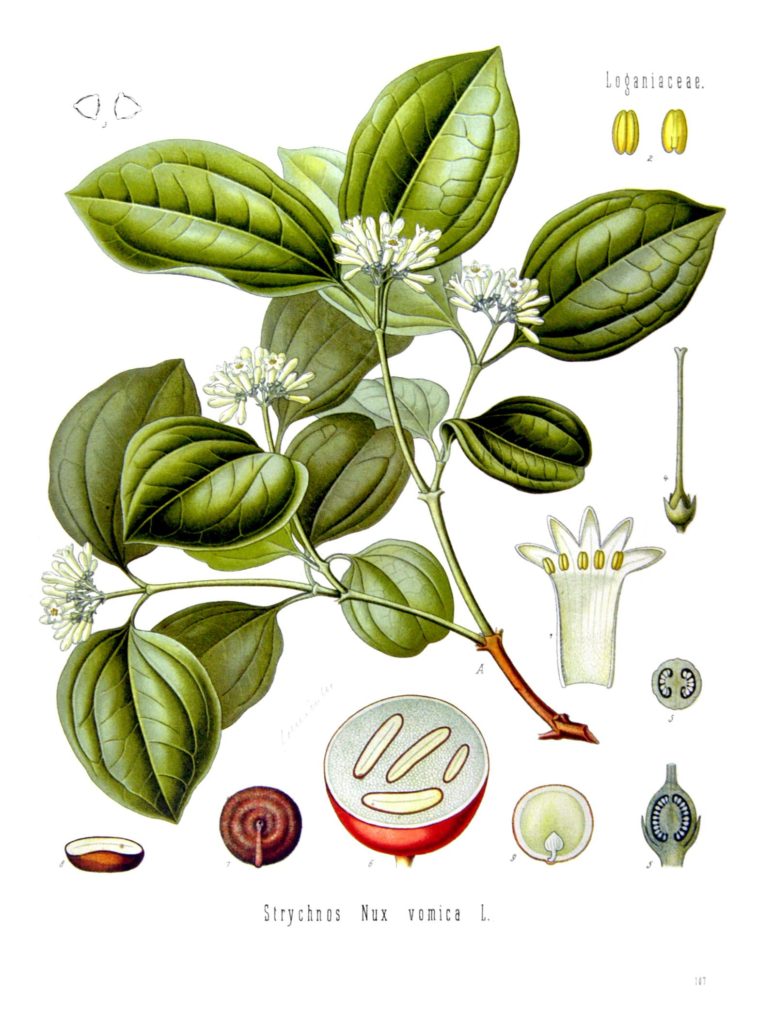Know Your Remedies: Nux Vomica (Nux.)
 Common Name: Poison nut: Quaker buttons.
Common Name: Poison nut: Quaker buttons.
General Information
Nux Vomica is prepared from the strychnine-containing seeds of the Strychnine or Poison Nut tree. Once prepared in homeopathic potencies, the remedy is non-toxic and safe for use with infants through to the elderly. Those who need Nux Vomica do things to excess. They overwork and overindulge in food, coffee, stimulants, and alcohol (it is a key remedy for hangover). They are competitive, driven, irritable, and intolerant of the shortcomings of others. Eventually, nervous exhaustion leads to sleep difficulties, and sensitivity to smells, light, and sound. Pains are cramping and spasmodic, and worsened by sedentary habits.
Hayfever
- Sneezing on waking or after eating.
Colds
- Nose runs during the day but blocked or stuffy at night.
- Better for fresh air and worse for warm, stuffy rooms.
Flu
- High fever with chills, backache, shivering, and sweating.
- Chilled by the slightest draft or movement under the big clothes.
- Sore, bruised pains in bones and joints.
Headaches
- Worse in the morning after overindulgence (hangover), loss of sleep or mental strain.
- Bilious, dizzy, and oversensitive to light, noise, smells. Sleeplessness
- From mental exertion, worry, or alcohol.
- Wakes between 3 to 4 a.m. and falls asleep again when time to get up.
Digestive Problems
- Indigestion from alcohol, rich food, or coffee, or mental strain.
- Gastritis and ulcers.
- Bitter, sour belching. Flatulence from tight clothing.
- Cramping pains better for warmth or warm drinks.
- Vomiting, diarrhoea or constipation with ineffectual urging.
- Constipation from sedentary habits, travelling, overeating.
Cystitis
- Constant urging, relieved by sitting in a warm bath.
For Pets
- Digestive upsets after excessive or rich food.
- Irritability with constipation.
- Poisoning by noxious plants
Where do I find it?
Nux Vomica (Nux) is available from our online store as a single remedy and is also included in the following Complexes (combination remedies): Colic; Common Cold – Watery; Hay Fever; Headache – Migraine; Indigestion; Jet-Lag; Nausea; Over-indulgence & Hangover; Reflux; Smoke Stop; Snore Ease; Teething; Winter Defence.
Home Treatment Guidelines
Acute, Self-Limiting Conditions
Conditions like colds or minor injuries, which are short-term and typically improve on their own, can be managed at home with homeopathy. However, in emergencies or if symptoms worsen, contact your healthcare provider.
Chronic Conditions
These home treatment instructions do not apply for ongoing issues, whether mentioned above or not, like persistent allergies or chronic pain. You should consult a qualified homeopath for a personalized treatment plan to achieve the best results with homeopathy for chronic conditions.
How to Take the Remedy for Acute Conditions
- Take one pill or five drops of the remedy. The frequency depends on symptom severity. As examples:
- For life-threatening symptoms, take every 1 minute and seek emergency help immediately.
- For mild symptoms, take every 4 hours.
- Stop taking the remedy once you feel better. Resume if symptoms return.
- If no improvement after four doses, choose a different remedy or consult a professional homeopath.
- For more details on dosing, refer to: How Often to Dose with a 30C Homeopathic remedy.
- For information on the different potencies, read: Guidelines on which potency to use
Additional Notes From Past Masters
Homeopathy is a 200-year-old system of medicine. Early homeopaths recorded detailed notes on how remedies worked, including initial tests, remedy relationships, and their experiences. These writings were shared to improve homeopathic practice and now offer fascinating insights into past uses of homeopathy. Here’s an example, edited and modernised for clarity, from Leaders In Homoeopathic Therapeutics (1898) by E. B. NASH M.D.:
Leaders In Homoeopathic Therapeutics by E. B. Nash M.D.
Nux Vomica (Nux-v.)
For very particular, careful, zealous persons, inclined to get excited or angry, spiteful, malicious disposition, mental workers or those having sedentary occupations.
Over-sensitiveness, easily offended; very little noise frightens, cannot bear the least even suitable medicine; faints easily from odors, etc.
Twitchings, spasms, convulsion, < slightest touch.
Chilliness, even during high fever; least uncovering brings on chilliness. Very red face.
Persons addicted to stimulants, narcotics, patent medicines, nostrums, debauchees, etc.
Frequent and ineffectual desire for stool or passes little at a time, > after stool.
Modalities: < uncovering, mental work, after eating, cold air, dry weather, stimulants, 9 A. M.; > wet weather, warm room, on covering, after stool.
Spasm (from simple twitchings to the clonic form); sensitiveness, nervous and chilliness are three general characteristics of this remedy.
Anxiety with irritability and inclination to commit suicide, but is afraid to die.
Sleepy in the evening, hours before bedtime; lies awake for an hour or two, at 3 or 4 A. M., then wants to sleep late in morning.
Awakens tired and weak and generally worse, with many complaints.
Stomach: Pressure an hour or two after eating as from a stone (immediately after, Kali bi., Nux m.).
Convulsions with consciousness (Strych.); < anger, emotion, touch, moving, alternate constipation and diarrhea (Ant. crud.).
Menses: Too early, profuse and lasting too long, with aggravation of all other complaints during their continuance.
Nux vomica acts better when given at night, during repose of mind and body; Sulph. in the morning.
* * * * *
Among the symptoms called characteristic, as given by Constantine Hering, are these:
“After aromatics in food or as medicine, particularly ginger, pepper, etc., and after almost any kind of so-called ‘hot’ medicines (Goullon).” Also, “will also benefit persons who have been drugged by mixtures, bitters, herbs and so-called vegetable pills, etc. -(B.)”
This is putting it in too wholesale a fashion.
It would be true if said that Nux vomica will often benefit such cases. The fact is that it will benefit those cases in which the use of such drugs, aromatics, pills, etc. has brought about a condition that simulates the symptoms produced in the provings of Nux vomica, or in cases to which it is homoeopathic and no others.
Another fact is that things often do produce such a condition, and that is one reason why so many physicians are invariably prescribing Nux vomica the first thing, in cases coming from allopathic hands, without even examining the case, but it is unscientific.
We have a law of cure and there are cases in which the Nux vomica condition is not present but another more similar remedy must be given. It does not alter the case to say, “Well, I did not know what had been given,” for Nux vomica will neither antidote the effects of the drug poison nor cure the disease condition unless it is homoeopathically indicated, especially given in the dynamic form.
Here are two more of Hering’s card symptoms, in which are given the temperaments that are most susceptible to the action of Nux:
“Oversensitiveness, every harmless word offends, every little noise frightens, anxious and beside themselves, they cannot bear the least even suitable medicines – (B).” And, “For very particular, careful, zealous persons, inclined to get excited and angry, or of a spiteful, malicious disposition.”
This is a graphic picture of what is called the “Nervous temperament,” and practice corroborates the truth of the value of these temparametic indications for this remedy; but there are a number of remedies that have as markedly this so called nervous temperament, such as Chamomilla, Ignatia, Staphysagria, and others.
So no physician would be justified in prescribing Nux vomica on temperament alone, be the indication ever so clear. The whole case must come in. There seems to be another kind of condition belonging to this nervous group of Nux vomica that has not so much of excitability in it. “Hypochondriasis, with studious men, sitting too much at home, with abdominal complaints and costiveness.”
Now if you take a second look at these cases, you will find that a very little irritation will arouse their kind of their hypohondriac gloom and make them angry or irritable similar to the first condition, so that on the whole the first proves to be the predominant one.
If the gloomy or hypochondriac condition of mind persist, we will more likely have to look to such remedies as Aurum, Nat. mur., etc., to find the true similimum. These nervous symptoms of mind and body are wonderful leaders to the selection of the right remedy.
“Frequent and ineffectual desire to defecate or passing but small quantities of feces at each attempt.”
This symptom is pure gold. There are a few other remedies that have it, but none so positively and persistently.
It is the guiding symptom in the constipation to which Nux vomica is homeopathic, and in my experience will then, and then only, cure.
Carroll Dunham wrote over twenty-five years ago on this symptom. He said, in effect -while Nux vomica or Bryonia are equal remedies for constipation there was never any reason for confounding them, or alternating them, as they were so different. The Nux vomica constipation was caused by irregular peristaltic action of the intestines, hence the frequent ineffectual desire; but the Bryonia constipation was caused by lack of secretion in the intestines. There was with Bryonia absolutely no desire, and the stools were dry and hard as if burnt.
And the above symptom is found not in constipation alone. It is always present in dysentry. The stools, though very frequently consisting of slimy mucus and blood, are very small and unsatisfactory.
Dr.P.P. Wells pointed out the very reliable additional symptom for Nux vomica in dysentry -that the pains were very greatly relieved for a short time after every stool. This is not so with Mercury, but the pain and tenesmus continue after the stool, as it is sometimes well expressed as “a never-get-done” feeling. But it makes little difference whether the patient is afflicted with constipation, dysentry, diarrhoea or other diseases, if we have this frequent ineffectual desire for stool present we always think of Nux vomica first, and give it unless other symptoms contra-indicate it.
“Catamenia a few days before time, and rather too copious, or keeping on several days longer with complaints at the onset, which remain until after it is over.”
This is also an oft verified symptom of Nux vomica. Of course there are many other remedies for too early or too copious menstruation. Calcarea Ostrearum is not at all like Nux vomica.
I have found that patients that required Nux vomica., for this condition could hardly ever take Pulsatilla for anything. For instance, if the patients had green, bland, thick discharge and you gave them Pulsatilla it would often bring down too early and profuse menses. In such cases I had to give Sepia which would act like a charm on the catarrh and not aggravate the menses.
These cases calling for Nux vomica. often occur in young girls or women at the climacteric. We often have the characteristic rectal troubles also present (Lilium tig.). The pains are pressing down and extend to the rectum and sometimes also to the neck of bladder.
Inefficient labour pains, extending to the rectum, with desire for stool or frequent urination, are quickly relieved, and become efficient, after the administration of a dose of Nux vomica 200.
If, in addition, your menorrhagic patient is costive, has gastric troubles, and especially if generally < in the morning, we have an almost sure remedy in Nux vomica.
“Feels worse in the morning soon after awaking (Lach. and Nat. mur.), also after mental exertion (Nat carb., vertigo; Calc. ost., Sil., occipital); after eating (Anac. card., reverse) and in cold air (Puls., reverse)”
If Boenninghausen had never done anything but given us his incomparable chapter on aggravations and ameliorations, this alone would have immortalised him.
It seems to me, after profiting them in a practice of over thirty years, it is impossible to over estimate them. But some one will say perhaps -there are twenty-eight remedies in Allen’s Boenninghausen., in large caps, that are worse in the morning. That does not seem like coming very close to the choice of the remedy.
But when we look at those that are worse in the evening, we find thirty-eight remedies, and only eight of them occurring under both morning and evening, and these eight are worse not generally, but rather in some especial symptoms. For instance, in Rhus the loose cough is worse in the morning, the tight dry one in the evening.
So you see we are quite on the way to making a choice after all. But now take all the aggravations of Nux vomica as regards time, mind, gastric (symptoms), temperature etc., where can you find the combination so prominently under any remedy? Of course those physicians who are not able to appreciate anything but pathological symptoms have not much use for these modalities. But one thing is certain, they cannot do as good homeoopathic work without as with them.
“Great heat, whole body burning hot, especially face red and hot, yet the patient cannot move or uncover in the least without feeling chilly.” This condition of feverishness is of common occurrence and yields to Nux vomica with a promptness that would delight the heart of a Lippe.
It makes no difference what the name of the fever, whether inflammatory, remittent or fever accompanying sore throat, rheumatism, or any other local trouble, if we have these indications, we may confidently give this remedy and will not be often disappointed with the result.
It took me years to learn the value of this symptom, because I was a routinist and thought that Aconite, Belladonna, or both in alteration, must be given in all cases where high fever was present. So I have some sympathy for young physicians now, who from false teachings have been led to the same error. But let me say here, for the benefit of all such, that there is a much better way: namely -to closely individualize, which is not always difficult; give the single remedy in the potentised form, giving it time to act, and wait for reaction before repeating.
Of course low potencies will often cure, and that in spite of alternation, over dosing and frequent repetition. But they will often fail, and in the great majority of cases will not accomplish anything like the satisfactory results of the true similimum, the single remedy and the single dose.
“After eating: (Kali bich., Nux moschata) sour taste pressure in the stomach an hour or two afterward, with hypochondriacal mood, pyrosis tightness about the waist; must loosen clothing (Lachesis, Calcarea, and Lycopodium), confused cannot use mind two or three hours after meal, epigastrium bloated, with pressure as from a stone in the stomach.”
This is a group of symptoms as given in “Guiding Symptoms.” There are so many symptoms given under the digestive organs that it shows that Nux vomica has really very wide range of action in gastric troubles. And there are no really characteristic and peculiar symptoms to mention, unless it be the peculiar aggravation of the stomach symptoms “an hour or two after eating,” instead of immediately after as is the case with Nux moschata and Kali bichromicum. The pressure as from a stone occurs also in Bryonia and Pulsatilla.
More stress may be placed upon the cause of the stomach, liver and abdominal complaints for which Nux vomica is the remedy. For instance, coffee, alcoholic drinks, debauchery, abuse of drugs, business anxiety, sedentary habits, broken rest from long night watching (Cocc., Cup. met., Nit. ac.), too high living etc. So we find that Nux vomica is adapted to complaints arising from these causes, which is abundantly verified in practice.
One thing is very apt to be present in these cases: namely -the very characteristic rectal symptoms already noticed.
We ought not to leave Nux vomica without speaking of its great efficiency in headaches and backaches.
The headache often occurs in conjunction with gastric, hepatic, abdominal and hemorrhoidal affections. Here also the modalities, more than the character of the pain, decide the choice.
The aggravations are: from mental exertion, chagrin or anger; in open air (opposite Pulsatilla), on waking in the morning, after eating, from abuse of coffee or spirits, sour stomach, in the sunshine, on stooping, from light and noise, when moving or opening the eyes (Bryonia), from coughing high living or highly seasoned food, in stormy weather, after drugging, from masturbation, from constipation or haemmorhoids.
These headaches may or may not localize in any part of the head.
The patient is just as apt to say in one part of the head as another, and will often say, in no particular part, “it feels badly and aches all over.”
The pains in the back are more peculiar. The patient is apt to have backache in bed, and must sit up to turn over; as turning or twisting the body, aggravates when standing (Sulphur) (worse when sitting, Kobalt, Pulsatilla, Rhus toxicod., Zincum) or sitting is especially painful. The pain is mostly located in the lumbar region, though it may be in the dorsa, and is often in connection (like Aesculus hipp.) with haemorhoids. Aesculus is especially < from walking or stooping.
Backache caused by masturbation (Kobalt, < sitting; Staphysagria, lying at night) finds one of its best remedies in Nux vomica. We might here launch out into a description of the general action of Nux vomica upon the spinal cord, including the motor and sensory centers, etc. but that can all be found in other works.
So now we will leave Nux, except as we refer to it in comparison while writing of other remedies. In reviewing of what we have written, we are impressed that some may be led to think that we have narrowed down the sphere of this truly great remedy too much. Let us say here, that it is not our aim in this work to write exhaustively upon any remedy, but to point out a few of the chief virtues and the characteristic symptoms, around which all the rest revolve.
To write exhaustively would be to write a complete materia medica.
In actual practice there are two kinds of cases that come to every physician. One is the case that may be prescribed for with great certainty of success on the symptoms that are styled characteristic and peculiar (Organon § 153.) The other is where in all the case there are no such symptoms appearing; then there is only one way, viz, to hunt for the remedy that, in its pathogenesis, contains what is called the “tout ensemble” of the case.
The majority of the cases, however, do have, standing out like beacon lights, some characteristic or key note symptoms which guide to the study of the remedy that has the whole case in its pathogenesis.







